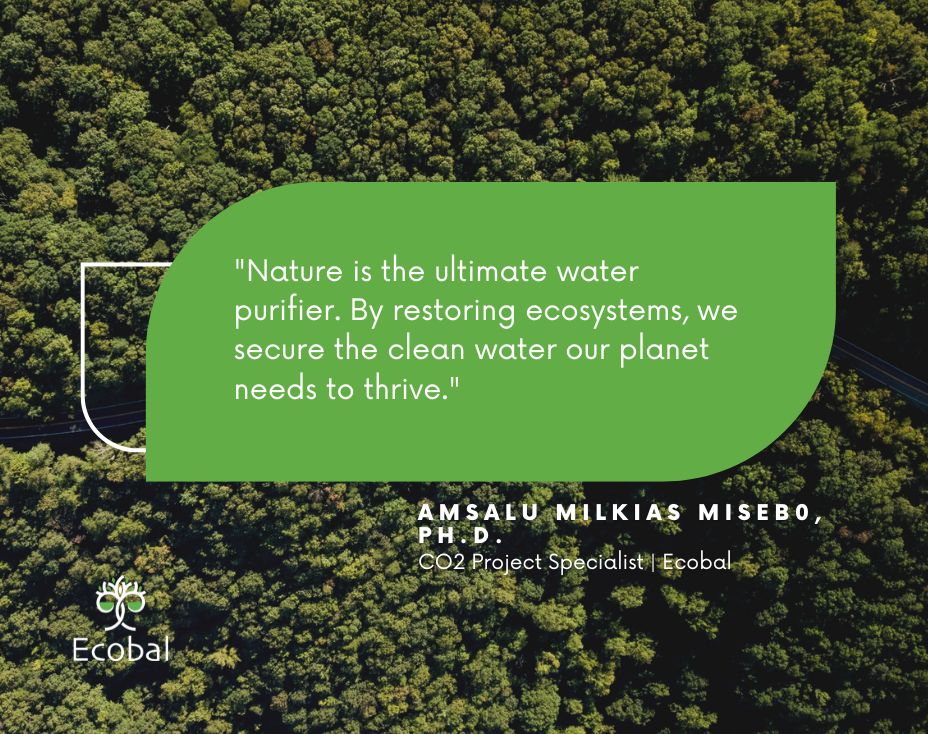The Water Cycle and Nature: How Natural Ecosystems Purify and Distribute Water
At Ecobal, we believe that nature’s systems offer the most effective solutions to global challenges, including water purification and distribution. The water cycle—powered by evaporation, condensation, precipitation, and runoff—ensures that life on Earth is sustained through a constant flow of fresh water. However, the crucial role that natural ecosystems play in maintaining this cycle is often overlooked.
By restoring and enhancing nature’s natural systems, we can ensure that clean water continues to flow, supporting biodiversity, ecosystems, and human communities alike. Here’s how the water cycle works, and why restoring nature’s balance is key to its sustainability.
The Water Cycle: Nature’s Flow of Life
The water cycle, or hydrologic cycle, involves the continuous movement of water between the Earth’s surface and the atmosphere. It’s essential for life, biodiversity, and maintaining ecological balance. The cycle’s stages include:
- Evaporation & Transpiration: Solar energy causes water from oceans and rivers to evaporate into the atmosphere. Plants also contribute through transpiration, releasing water vapor (USGS Water Cycle Overview).
- Condensation: The water vapor cools and forms clouds through condensation (National Geographic – The Water Cycle).
- Precipitation: As water droplets gather in clouds and become too heavy, they return to Earth as precipitation.
- Infiltration & Runoff: Precipitation infiltrates the soil, replenishing aquifers, or runs off into rivers, lakes, and oceans.
Nature’s Role in Water Purification
At Ecobal, we recognize that nature is the ultimate water purifier. Through natural processes, ecosystems remove pollutants and ensure clean, safe water. Here are some of nature’s most important filtration systems:
- Wetlands as Natural Filters: Wetlands act as nature’s kidneys, filtering out pollutants such as sediment, nutrients, and heavy metals. Wetland ecosystems provide critical water filtration services through both biological and chemical processes (EPA – Wetlands and Water Quality).
- Forests & Vegetation: Forests stabilize soil, reduce erosion, and facilitate water absorption. They also regulate local precipitation patterns, which helps maintain a steady supply of clean water (FAO – Forest Hydrology and Water Cycle).
- Soil & Aquifers: Soil acts as a natural filter as water percolates into underground aquifers, removing pathogens and pollutants in the process (Scientific American – Soil Filters Water).

Human Impact on the Water Cycle
Human activities like deforestation, urban expansion, and unsustainable agricultural practices have disrupted these natural processes. Without healthy ecosystems to filter water and regulate its flow, the water cycle becomes strained, leading to water scarcity, pollution, and flooding. Here are some of the ways human activity impacts the water cycle:
- Deforestation: The loss of trees reduces the natural filtration capacity of ecosystems. Without forests to stabilize soil and absorb rainfall, water runs off quickly, leading to erosion and water contamination (WWF – Impacts of Deforestation on Water Resources).
- Urbanization: The destruction of wetlands and floodplains for urban development limits nature’s ability to filter water. Additionally, concrete and asphalt surfaces increase runoff and prevent water from infiltrating the ground (NCBI – Urbanization and Water Quality).
- Agriculture & Water Pollution: Intensive farming introduces fertilizers, pesticides, and chemicals into water systems. Nature’s ability to purify water is overwhelmed when pollutants exceed the filtration capacity of wetlands, forests, and soil (UNEP – Agricultural Pollution and Water Quality).
Restoring Nature’s Role in the Water Cycle
The solution to these disruptions lies in restoring the natural systems that maintain the water cycle. By re-establishing wetlands, forests, and sustainable agricultural practices, we can enhance nature’s capacity to purify water and ensure a sustainable, balanced flow of clean water.
- Wetland Restoration: Wetlands are among the most effective systems for filtering water. By restoring wetlands, we can improve their ability to filter pollutants and support biodiversity, all while ensuring water quality (Nature Conservancy – Wetland Restoration and Water Purification).
- Reforestation & Watershed Management: At Ecobal, we focus on restoring forests that not only capture carbon but also stabilize soils and manage water flows. Healthy watersheds are key to ensuring a continuous supply of clean water (UNDP – Reforestation and Watershed Protection).
- Sustainable Agriculture: By promoting sustainable farming practices, we can reduce the flow of harmful chemicals into water systems. This includes reducing pesticide use, maintaining buffer zones along waterways, and prioritizing soil health (FAO – Sustainable Agriculture and Water Conservation).
Why It Matters for Ecobal
At Ecobal, our mission goes beyond CO2 sequestration. We are committed to revitalizing ecosystems that support life in all its forms. Water is at the heart of all ecosystems, and by restoring degraded lands, we are restoring the natural processes that purify and distribute water.
Our projects focus on the long-term health of the planet. By creating thriving ecosystems, we’re ensuring clean water for generations to come while turning CO2 into a valuable asset stored in nature’s own warehouses.
About the Author:
This article is written by Dr. Amsalu Milkias, Ecobal’s CO2 Project Specialist. Dr. Amisalu has a Ph.D. in Restoration Ecology and has published extensively on ecosystem restoration and sustainable land management. His work at Ecobal focuses on integrating cutting-edge solutions to enhance biodiversity and CO2 sequestration.


